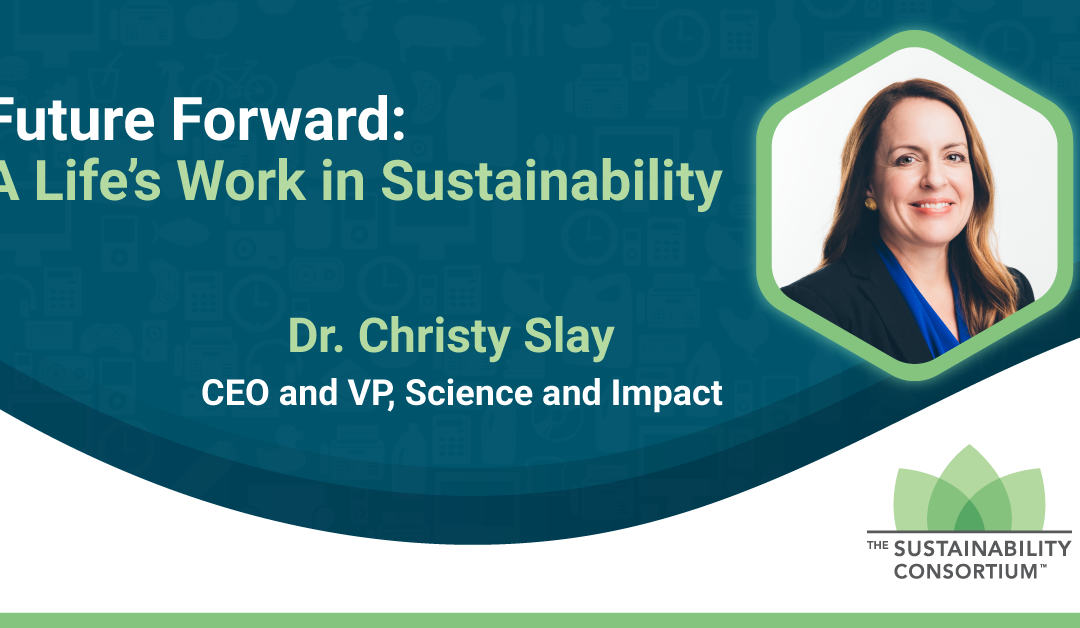This particular webcam interview was recorded by Todd Danielson, the editorial director of Informed Infrastructure. You can view a video of the full interview above or by visiting bit.ly/3BRWzoJ.
Dr. Christy Slay is the CEO and vice president, Science and Impact, The Sustainability Consortium (TSC).
Dr. Christy Slay has been involved with The Sustainability Consortium (TSC) since it was just a concept—even before it officially was born 12 years ago. TSC consists of universities, corporations and nonprofits, and she’s been involved in roles ranging from student to CEO. It’s literally her life’s work.
“Our staff work with our corporate and NGOs and other university stakeholders to develop a science-based platform to be able to measure product sustainability, so retailers have a consistent system globally to evaluate and assess their supplier’s sustainability performance,” she explains.
What Is Sustainability?
Sustainability is an elusive word with many definitions, but Slay describes it in terms of her consortium as “focused on using resources in a way that doesn’t impact future generations.” TSC hopes to become a brand label, like “LEED” or “Good Housekeeping,” that researches products’ practices and supply chains so consumers don’t have to.
“As a consumer, when you go to the store, you can be assured that on the shelf is a sustainable product, that you don’t have to sort through labels and various claims,” she notes.
Main THESIS
The Sustainability Insight System (THESIS) is the main platform for TSC. It helps retailers assess the product sustainability of their direct suppliers across environmental and social issues.
“Our team has developed and pulled together the leading peer-reviewed science across anything you can buy in a retail store or online,” says Slay. “We’ve pulled together what we call ‘hotspots,’ those key environmental or social issues that are embedded in the processes and all the way through end of life and disposal of a product.”
TSC highlights hotspots and has developed key performance indicators and consistent measurements to track improvement in areas such as greenhouse gas emissions, water use and labor rights. Retailers using the THESIS platform include Walmart, Sam’s Club, Walgreens, Walgreens Boots Alliance, Kroger and Amazon.
Personal Passion
Although she must think about many facets of sustainability in her role as CEO of TSC, her passion concerns forests and deforestation, which has led to a lot of work related to the science around forest loss—especially tropical forest loss. She describes tropical forests as “the world’s air conditioner,” as forests help cool the planet and sequester the most carbon.
“We’ve worked with the World Resources Institute, which is a leading science-based organization, to try to predict what the key drivers of forest loss are, so we can address those with our corporate partners,” says Slay. “What we’re finding is, like most commodities, it’s very difficult to trace. We are often trying to determine what’s behind a usually economic driver to deforest tropical forests.”
As an example of the negative consequences of deforestation, she discusses palm oil, which is relatively cheap and starting to replace soybean oil and other types of vegetable oil. But palm oil is only grown on two main countries, Indonesia and Malaysia, which has led to widespread deforestation that has been very detrimental to the native ecosystems.
“There’s always the other side of creating and ramping up a new supply, and a new supply chain, that really has a lot of unintended consequences that we now have to manage,” she adds.
How Can Engineers Help?
Slay notes that engineers are vital to the sustainability cause because they’re the ones building long-term resilience in our infrastructure. She offers a couple tips to keep in mind when designing infrastructure.
“Obviously, the materials used in building are critical, looking at the impacts of supply chains and understanding how to source sustainably when designing and building,” she explains, adding that much innovation is now taking place in creating more-sustainable materials such as wood, concrete and steel. “The other thing to keep in mind is planning, designing and building for resilience. Our climate is changing, and we need to be thinking long term about the weather patterns, and the other types of disruptions that are going to happen, as related to climate change.”

